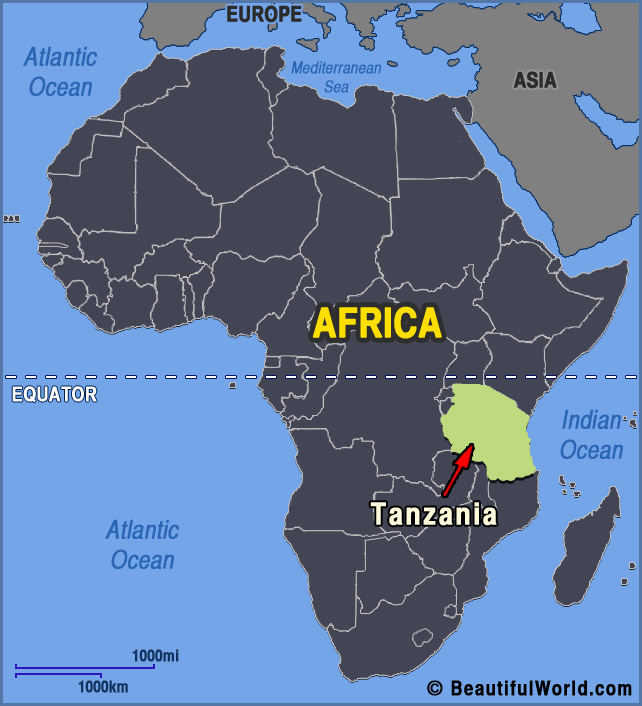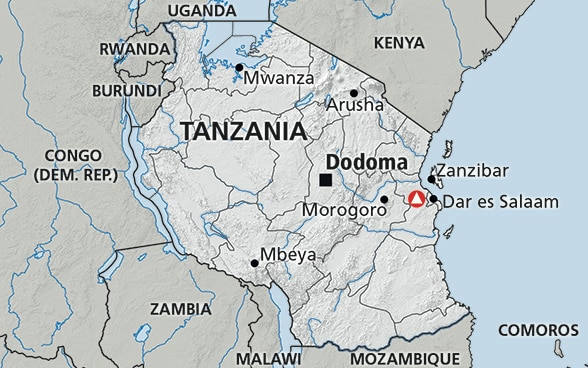About Tanzania
Tanzania, officially the United Republic of Tanzania, is a country on the eastern coast of Africa within the great lakes region. Tanzania is home to 55.5 million people (July 2018).

History:
Shortly after achieving independence from Britain in the early 1960s, Tanganyika and Zanzibar merged to form the United Republic of Tanzania in 1964. In 1995, the first democratic elections were held in the country since the 1970s. Zanzibar maintains semi-autonomy and participates in national elections.
Capital:
Legislative capital: Dodoma
Administrative capital: Dar es Salaam
Geography:
Area:
945,087 square kilometers (364,900 square miles). For comparison this is slightly larger than twice the size of California or three times that of New Mexico!
Land Borders:
The Tanzania mainland is bounded by Uganda and Kenya to the north, by Mozambique, Malawi, and Zambia to the south and southwest, and by Burundi, Rwanda and Democratic Republic of the Congo to the west.
Water Borders:
The east coast of Tanzania is the Indian Ocean. Tanzania also contains three of Africa’s best-known lakes - Lake Victoria (the world’s second-largest freshwater lake) in the north, Tanganyika (the world’s second deepest) in the west, and Nyasa (Lake Malawi) in the south.
Elevation:
Highest point: Mount Kilimanjaro (highest point in Africa), 5,895 m (19,340 ft)
Lowest point: Indian Ocean, 0 m
Mean elevation: 1,018 m
Zanzibar Island:
The island of Zanzibar is separated from the mainland by a 22-mile channel.

Climate:
Varies from tropical along coast to temperate in highlands. There are four principle climatic and topographic areas: the hot and humid coastal lowlands of the Indian Ocean shoreline, the hot and arid zone of the broad central plateau, the high inland mountain and lake region of the northern border, and the highlands of the northeast and southwest, the climates of which range from tropical to temperate. Tanzania’s warm equatorial climate is modified by variations in elevation. Roughly half of mainland Tanzania receives less than 30 inches (750 mm) of precipitation annually, an amount considered to be the minimum required for most forms of crop cultivation in the tropics.
Languages:
Swahili (Kiswahili), Kiunguja (name for Swahili in Zanzibar), English, and over 120 local languages. Swahili and English are the two official languages. Swahili, the national language, is a composite of several Bantu dialects and Arabic that originated along the East African coast and on the island of Zanzibar. Swahili is the lingua franca of the country, and virtually all Tanzanians speak it. In addition to Swahili, most African Tanzanians also speak the traditional language of their ethnic group. Swahili is also used as the medium of instruction in the first seven years of primary education. English is the medium of instruction at higher levels of education and is widely used in government offices.
Ethnicity:
Mainland:
African 99% (of which 95% are Bantu consisting of more than 130 tribes), other 1% (consisting of Asian, European, and Arab);
Zanzibar:
Arab, African, mixed Arab and African
Religion:
Christian 61.4%
Muslim 35.2% (Zanzibar is almost entirely Muslim)
folk religion 1.8%
other 0.2%
unaffiliated 1.4%
Demographics:
Tanzania has the largest population in East Africa and the lowest population density; almost a third of the population is urban. Tanzania’s youthful population – about two-thirds of the population is under 25 – is growing rapidly because of the high total fertility rate of 4.8 children per woman.
Life expectancy:
Total population: 63.1 years
Male: 61.6 years
Female: 64.6 years (2018 est.)
Median Age:
Total: 17.9 years
Male: 17.6 years
Female: 18.2 years (2018 est.)
Economy:
Tanzania is one of the world’s poorest economies in terms of per capita income, but has achieved high growth rates based on its vast natural resource wealth and tourism. The economy depends on agriculture (coffee, tea, sisal, cotton, cashews, and tobacco), which accounts for more than one-quarter of GDP, and employs about 65% of the workforce. Gold production in recent years has increased to about 35% of exports. All land in Tanzania is owned by the government, which can lease land for up to 99 years. 22.8% of the population is living below the poverty line.
Currency:
Tanzanian shillings (TZS) 1 US Dollar = 2302 TZS (as of 2017)
Amenities:
Access to improved drinking water: 55.6% of population
Access to improved sanitation facilities: 15.6% of population
Population without electricity: 37.4 million
Internet users: 13% of population
Mobile telephones: 74 subscriptions per 100 inhabitants

Fun Facts:
- The flag of Tanzania carries in it the 4 elements of Tanzania’s daily life. The green represents nature’s beauty, the yellow represents the mineral deposits of the country, the black represents the people, while the blue represents the great lakes.
- The country has designated 25% of its land to wildlife sanctuaries and national parks.
- Mpingo tree, found in Tanzania produces the costliest timber in the world. It has exceptional mechanical properties that make it perfect for carving and it has a beautiful finish.
- The most famous national park of Tanzania is the Serengeti National Park when a million wildebeests cross over to the Masai Mara National Park in Kenya. This migration is so epic, that it is named as one of the seven natural wonders of the world.
- Tanzania is home to the Ngorongoro Crater, the world’s largest caldera, or volcanic depression. The crater has an area of 264 kilometers. It is estimated to have formed about 2.5 million years ago.
- Mount Kilimanjaro is the highest peak in Africa and is the tallest free-standing mountain in the world. The iconic mountain is a world in itself, with a staggering five different types of climatic zones, from hot tropical forests to arid snow-capped peaks. In comparison, the whole of the US has a total of 7 climatic zones.
- One of the key reasons for poverty is the low pace of urbanization. More than 80% of the population lives in rural areas, which lack basic civic amenities like electricity, sanitation facilities, and education.
- It is thought that Tanzania has the largest population of Albinos in Africa. Albinos are at risk of killing and dismembering due to superstitions in some areas. There are campaigns to try and stop the persecution of Albinos.
- There are 310 mammal species and 960 bird species in Tanzania, mostly in their game reserves and national parks.
- The national anthem of Tanzania is “Mungu ibariki Afrika” (God bless Africa). It is shared with South Africa and Zimbabwe and is sung in Swahili.
- Freddie Mercury, the famous late songwriter and vocalist for the rock band ‘Queen’ was born in Zanzibar, Tanzania.
- Tanzania is divided into 26 regions (mikoa), 21 on the mainland, 3 on Zanzibar Island and 2 on Pemba Island.
- Lake Manyara National Park is the home to the world’s only tree climbing lions.